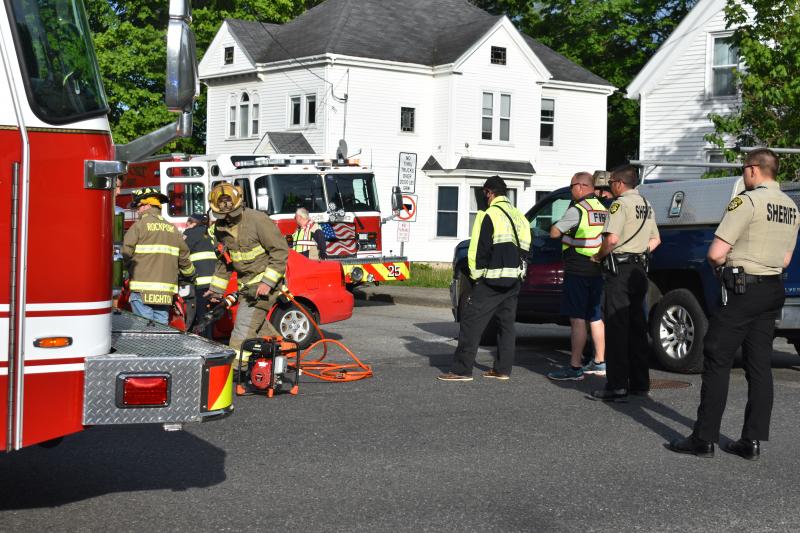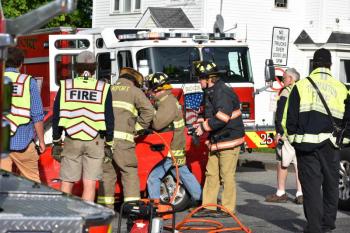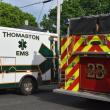Simultaneous CPR call, minor vehicle crash in Rockland draw mutual aid, highlight reason for CPR device request
ROCKLAND — A minor motor vehicle accident in Rockland drew responders from three mutual aid agencies, Tuesday afternoon, June 2, while Rockland Fire/EMS was busy with CPR resuscitation at a different medical call. The department recently submitted to the City a Capital Improvements Project request for three mechanical chest compressions devices as a way to free up responders.
At 5:37 p.m., Rockland’s on-duty Fire/EMS crew, along with their call-shift and some off-duty personnel, were dispatched to a location in Rockland to perform continuous chest compressions. It was an “all hands” call, according to Rockland Fire/EMS chief, Chris Whytock. Rockland police officers also responded, assisted with compressions while more Fire/EMS arrived. After being relieved of that task, police remained on scene to provide scene awareness and to gather medical history details from bystanders.
At approximately 5:45 p.m., a car and a pickup collided at the intersection of Broadway and Pleasant Street. Chief Whytock was able to break away from the CPR situation, but the rest of the crew of seven, along with Rockland Police, had to remain.
Pre COVID-19, six responders were needed for CPR calls. Now, with COVID-19, seven people are needed, and eight would be ideal, according to Whytock. The use of mechanical chest compression devices would free up a few of those people.
“It’s very odd to have a car accident in Rockland, and the only fire apparatus from Rockland that was there was Car 1 (the chief’s vehicle),” he said.
To cover the crash, Knox County Regional Communications Center called Rockport Fire Department to respond. A fire truck is always dispatched to a motor vehicle crash for three reasons, according to Whytock. First, the trucks block traffic, cutting down on the potential for responders to get hit by passing cars. Second, to be on scene in case a fire develops in the vehicle, or if fluids are leaking. Third, because that’s where the cutters and spreaders (aka jaws of life) are kept.
In this case, Rockport firefighters employed spreaders to open the car’s dented-in driver’s side door and free the driver, who was trapped inside.
After being freed, Thomaston Ambulance EMS providers transported the car’s driver to a local hospital.
The Knox County Sheriff’s Office covered the details of the crash, and the road reopened at 6:43 p.m.
“We have a really good mutual aid system in Rockland,” he said. “We’ve got Thomaston, Rockport, South Thomaston all around us. We’re very fortunate that we’ve got some highly skilled people around us that back us up. It’s a piece of mind and a good way to promote safety and keep everybody safe and healthy.”
The Rockland CPR crew returned to service after 7:30 p.m.
“Any time you have a cardiac arrest, or even a car accident, putting the apparatus back together takes time,” he said. “That’s two hours worth of stressful work, and then getting everything back in order.”
The case for mechanical compression devices
The survival rate of a patient in need of CPR, and under the care of Rockland EMS providers, has increased noticeably in the last decade, according to Rockland Fire/EMS Chief Chris Whytock. Without looking at the numbers, Whytock estimated the survival rate of Rockland’s cases pertaining to chest compressions has risen to around 40%.
As Rockland Mayor Lisa Westkaemper said during the May 27 continuation of budget talks, 40% is an impressive number.
Yet, success comes with a cost, and stems further than the price of salary to the on-duty personnel.
For this reason, Whytock has proposed using Capital Improvement Project dollars to fund three mechanical compression devices – one for each of Rockland’s three ambulances. Each device, without a service plan, could cost around $16,000. A few different companies sell the product, and the final cost to the City would depend on putting the product out to bid, according to him.
By repeatedly pushing a puck-like foam disc onto the patient’s sternum at a pre-determined depth and speed, the devices take the place of tiresome manual labor, and frees the providers to tend to the myriad of other crucial aspects such as performing oxygen ventilation, starting IV’s, pushing medications, preparing AEDs, consulting hospitals, and updating families.
Effective CPR without a mechanical device cannot be performed in an ambulance due to space constraints as well as the lack of a rigid surface under the patient. Rockland’s previous pre-hospital ideology centered around three to four crew members attempting a few rounds of CPR at the scene, but then rushing the patient into the ambulance and speeding to Emergency Department.
In the past four years, research has shown that success rates improved when more time was spent on CPR at the scene, according to Whytock. So, now, Rockland EMS sends its on-duty crew to the scene, plus off-duty personnel in the hopes that at least six authorized people continue the constant 80 - 100 compressions per minute. They swap technicians every two minutes as they check for a pulse and breathing, before reassessing the situation every 20 minutes. The EMS world refers to this as Pit Crew CPR, where everyone has a task and those tasks are done with a precision relatable to race-car mechanics.
With the extended time in the field, CPR in this manner often continues for 45 minutes to an hour, and may continue longer in the future.
“What we do in the field is exactly what would be done in any emergency room, and our early intervention is actually proven to be more successful,” he said.
If Rockland EMS only ever received one medical call at a time, the CPR event would be manageable – though exhaustion comes quickly to those on their hands and knees. However, Rockland tends to a population of approximately 7,000 people, while also servicing Owls Head medical calls, and responding to mutual aid towns when needed.
Twenty-five percent of the time, Rockland is called to at least one other location at the same time, according to Whytock. Sometimes all three ambulances are away from the station in three different directions, which means having only two crew members to initiate life-saving measures.
By lessening the manual burden, the devices free up resources after a mandatory two minutes of manual compression.
Freeing up resources, said State of Maine EMS Medical Director Matthew Sholl, is pretty much all that the devices would do.
In 2019, The Maine EMS Medical Direction and Practices Board approved usage of the mechanical compression devices based on two factors:
1) current evidence suggests the devices are not inferior to manual chest compression and,
2) interest and advocacy from the EMS community to implement the devices.
Three further criteria dictate when the device can be used:
1) Prolonged resuscitative efforts
2) Resuscitations with few responding EMS providers and
3) Rearrests en route to the hospital
Though Sholl expressed enthusiasm for Rockland’s increased success rate, he also stated belief that these rates are occurring in many other communities as well. One of the largest factors may be the efforts of local EMS services to engage in regular training on high-performance CPR techniques and coordination of the response to a cardiac arrest, according to him.
“High performance manual CPR is the foundation of response to a cardiac arrest,” he said.
Also contributing to the rate increase is community engagement, bystander CPR programs, public access to Automatic External Defibrillators, and advancements in hospital care for post cardiac arrest patients.
“The evidence we have presently suggests that mechanical CPR devices are not inferior to manual chest compressions,” he said, “but the evidence does not suggest the devices are in any way superior to manual chest compressions. Based on that information, I do not believe an EMS agency that has already dedicated time and energy to implementing a high performance CPR program should expect to see improvements in outcomes. That being said, the devices may support services in their efforts to resuscitate those suffering cardiac arrest.”
If Rockland City Council approves funding for the devices as they vote to approve the entire fiscal year 21 budget, June 22, the devices would be the first in the Midcoast, according to Whytock.
If so, once Rockland gets the devices into service, crew plan to meet with ED staff at Pen Bay Medical Center for ED trainings.
The devices, said Whytock, would effectively enhance Rockland’s ability to bring back life and sustain life.
Rockland Fire/EMS statistics
Calendar year 2019 was one of Rockland EMS’s busiest years with 2295 runs, which is an increase of about 300 calls from the previous year. And, that also included seeing a drop in mutual aid runs as well.
Average response time for lifethreatening fire and EMS calls within the City is 4 minutes and 40 seconds. About 4 minutes for EMS and a little bit longer time for the fire side of things due to the bigger trucks and dressing in fire gear.
About 26% of the time, at least one other call is going on at the same time, which correlates to about 500 times a year that two or less people are covering the station and are ready to respond to that third or fourth call.
Crew responded to 33 reports of fires last year, which is a small increase. Seventeen of the calls were not true structure fires.
The average time from notification of a fire in Rockland to the time that crew have gotten water on the fire is just under 8 minutes. “I don’t think that number can get any better,” said Fire/EMS Chief Chris Whytock. “That’s pretty impressive, and I’m proud of my team for being able to do that.”
On an average of about 22.8 times per month last year, the reported call kept the duty crew too busy to handle other calls, so off duty and call-shift crew were called in.
Wednesday is the busiest day. Between the hours of 8 a.m. and 4 p.m., is the busiest timeframe, with about half the runs occurring in that time.
Reach Sarah Thompson at news@penbaypilot.com

































